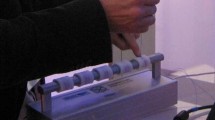Summary
The physical parameters of monofilament absorbable suture (Maxon and PDS) were studied. Compared to PDS Maxon proved somewhat more unwieldy, however, it required less complicated knot combinations for a secure placement than PDS did. In vivo experiments on rats showed a slight tissue reaction and a dissolution time of 120–180 days for Maxon and 180–240 days for PDS. With Maxon, tensile strength was measurable for 42–49 days, while the period for PDS amounted to 65–80 days. New indications for these materials are discussed, two parameters, easy knot formation and atraumatic passage through the tissue, especially favor the use of Maxon for one-row all-layer sutures in the gastrointestinal tract.
Zusammenfassung
Monofile, absorbierbare Nahtmaterialien (Maxon and PDS) wurden in physikalischen Grundgrößen untersucht. Im Handling erwies sich Maxon etwas sperriger als PDS, benötigt aber einfachere Knotenkombinationen als PDS bis zum sicheren Knotensitz. In vivo Versuche an Ratten zeigen eine schwachgradige Gewebereaktion und eine Auflösungszeit von 120–180 Tagen bei Maxon und 180–240 Tagen bei PDS. Maxon weist für 42–49 Tage, PDS für 65–80 Tage meßbare Zugfestigkeit auf. Neue Indikationen für diese Materialien werden erörtert. Insbesondere die Anwendung von Maxon im Gastrointestinaltrakt bei einreihigen, allschichtigen Nähten wird durch die guten vorteilhaften Parameter Knotenfunktion und atraumatisches Gewebedurchzugsverhalten gefördert.
Similar content being viewed by others
Literatur
Chu CC (1981) An in vitro study of the effect buffer on the degradation of polyglycolic acid sutures. J Biomed Mater Res 15:19–27
Herrmann JB (1973) Changes in tensile strength and knot security of surgical sutures in vivo. Arch Surg 106:707–710
Holmlund EW (1976) Physical properties of surgical suture materials: stress-strain relationship, stress relaxation and irreversible elongation. Ann Surg 184:189–193
Lünstedt B, Thiede A (1982) Standardisierung der Nachweisverfahren zur Objektivierung der linearen Fadenzug-, Knotenbruch- und Knotensitzfestigkeit verschiedener absorbierbarer und nicht absorbierbarer Nahtmaterialien. In: Thiede A, Hamelmann H (Hrsg) Moderne Nahtmaterialien und Nahttechniken in der Chirurgie. Springer, Berlin Heidelberg New York, S 16–25
Lünstedt B, Knoop M, Thiede A (1986) Survey of physical and handling properties of modern monofilament suture materials. Ann Surg (in press)
Rodeheaver GT, Thacker JG, Edlich RF (1981) Mechanical performance of polyglycolic acid and polyglactin 910 synthetic absorbable sutures. Surg Gynecol Obstet 153:835–841
Sachs L (1978) Angewandte Statistik, 5. Aufl. Springer, Berlin Heidelberg New York
Sanfilippo PM, Danielson GK (1972) Nylon bands for closure of median sternotomy incisions: An unacceptable method. Ann Thorac Surg 13:404
Salthouse TN, Matlaga BF (1976) Polyglactin 910 suture absorption and the role of cellular enzymes. Surg Gynecol Obstet 142:544–550
Steen S, Andersson L, Lowenhielem P, Stridbeck H, Walther B, Holmin T (1984) Comparison between absorbable and nonabsorbable, monofilament sutures for end-to-end arterial anastomosis in growing pigs. Surgery 95:202–208
Stillman RM, Sophie Z (1985) Repair of growing vessels - Continuous absorbable or interrupted nonabsorbable suture? Arch Surg 120:1281–1283
Tera H, Åberg C (1976) Tensile strengths of twelve types of knot employed in surgery, using different suture materials. Acta Chir Scand 142:1–7
Tera H, Åberg C (1976) The strengths of suture knots after one week in vivo. Acta Chir Scand 142:301–307
Tera H, Åberg C (1977) Strength of knots in surgery in relation to type of knot, type of suture material and dimension of suture thread. Acta Chir Scand 143:75–83
Thacker JG, Rodeheaver G, Moore JW, Kauzlarich JJ, Kurtz L, Edgerton MT, Edlich RF (1975) Mechanical performance of surgical sutures. Am J Surg 130:374–380
Thacker JG, Rodeheaver G, Kurtz L, Edgerton MT, Edlich RF (1977) Mechanical performance of sutures in surgery. Am J Surg 133:713–715
Thiede A (1982) Zur Neuentwicklung von Nahtmaterialien und den Möglichkeiten einer Beurteilung. In: Thiede A, Hamelmann H (Hrsg) Moderne Nahtmaterialien und Nahttechniken in der Chirurgie. Springer, Berlin Heidelberg New York, S 1–6
Thiede A, Hamelmann H (1982) Moderne Nahtmaterialien und Nahttechniken in der Chirurgie. Springer, Berlin Heidelberg New York
Thiede A, Stüwe W, Lünstedt B (1985) Vergleich von physikalischen Parametern und Handhabungseigenschaften kurzfristig und mittelfristig absorbierbarer Nahtmaterialien. Chirurg 56:803–808
Author information
Authors and Affiliations
Rights and permissions
About this article
Cite this article
Knoop, M., Lünstedt, B. & Thiede, A. Maxon und PDS — Bewertung physikalischer und biologischer Eigenschaften monofiler, absorbierbarer Nahtmaterialien. Langenbecks Arch Chiv 371, 13–28 (1987). https://doi.org/10.1007/BF01259240
Received:
Issue Date:
DOI: https://doi.org/10.1007/BF01259240




